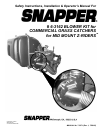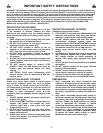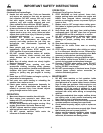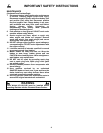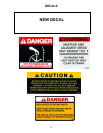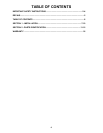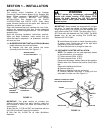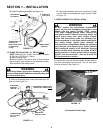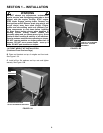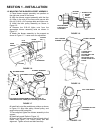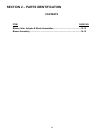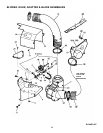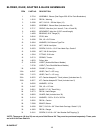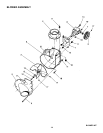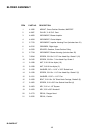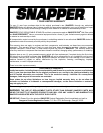
3
IMPORTANT SAFETY INSTRUCTIONS
PREPARATION
(Continued From Previous Page)
4. Handle fuel with extra care. Fuels are flammable
and vapors are explosive. Use only an approved
fuel container. DO NOT remove fuel cap or add
fuel with engine running. Add or drain fuel
outdoors only with engine stopped and cool.
Clean spilled fuel from machine. DO NOT smoke.
5. Practice operation of machine with BLADES OFF
to learn controls and develop skills.
6. Check the area to be mowed and remove all
objects such as toys, wire, rocks, limbs and other
objects that could cause injury if thrown by blades
or interfere with mowing.
7. Evaluate the terrain to determine what
accessories and attachments are needed to
properly and safely perform the job. Only use
accessories and attachments approved by
SNAPPER.
8. Keep people and pets out of mowing area.
Immediately, STOP blades, STOP engine, and
STOP machine if anyone enters the area.
9. DO NOT operate machine unless all shields,
deflectors, switches, blade controls and other
safety devices are in place and functioning
properly.
10. Make sure all safety decals are clearly legible.
Replace if damaged.
11. Protect yourself when mowing and wear
appropriate clothing including safety glasses,
long pants, ear protection, hardhat and substantial
footwear with good traction. Long hair, loose
clothing or jewelry may get tangled in moving
parts.
12. Know how to STOP blades and engine quickly in
preparation for emergencies.
13. Use extra care when loading or unloading the
machine into a trailer or truck.
14. Check grass catcher components frequently for
signs of wear or deterioration and replace as
needed to prevent injury from thrown objects
going through weak or worn spots.
OPERATION
1. Mount and dismount machine from left side.
2. Start engine from operator's seat. Make sure
blades are OFF and parking brake is set. Use seat
belts if provided.
3. DO NOT leave machine with engine running. Stop
engine. Stop blades. Set brake. Remove key.
4. DO NOT operate machine unless properly seated
with feet on foot rests or pedal(s).
5. DO NOT operate machine while under the
influence of alcohol or drugs.
OPERATION
(Continued From Previous Column)
6. STOP MACHINE on level ground, lower deck,
engage parking brake and make sure engine and
blades have stopped before removing grass
catcher or unclogging mower to prevent injury to
hands or feet.
7. Blades must be OFF except when cutting grass.
Set blades in highest position when mowing over
rough ground.
8. Keep hands and feet away from rotating blades
underneath deck. DO NOT place foot on ground
while BLADES are ON or machine is in motion.
9. DO NOT operate machine without entire grass
catcher or guards in place. DO NOT point
discharge at people, passing cars, windows or
doors.
10. Slow down before turning.
11. Watch out for traffic when near or crossing
roadways.
12. STOP engine immediately after striking an object
or if an abnormal vibration occurs. Remove key.
Remove and disconnect the sparkplug wire. Make
necessary repairs before resuming operation.
13. Mow only in daylight or with good artificial light.
14. Move motion control levers SLOWLY to maintain
control during speed and directional changes.
15. Exercise CAUTION when pulling loads. DO NOT
pull loads greater than 300 pounds. Avoid jack
knifing. DO NOT turn sharply.
16. DO NOT operate engine in enclosed areas. Engine
exhaust gases contain carbon monoxide, an
odorless and deadly poison.
MAINTENANCE
1. DO NOT store machine or fuel container inside
where fumes may reach an open flame, spark or
pilot light such as in a water heater, furnace, clothes
dryer or other gas appliance. Allow engine to cool
before storing machine in an enclosure. Store fuel
container out of the reach of children in a well
ventilated, unoccupied building. Shut off fuel (when
equipped with valve) while storing or transporting
machine.
2. Clean grass and debris from engine, mufflers, drives
and cutting units to help prevent overheating and
fires. Clean up fuel, oil and excess grease.
3. When draining fuel tank, drain fuel into an approved
container outdoors and away from open flame.
4. Check brakes frequently; adjust, repair or replace as
needed.
5. Keep all bolts, nuts and screws properly tight. Check
that all cotter pins are in proper position.
6. Always provide adequate ventilation when running
engine. Engine exhaust gases contain carbon
monoxide, an odorless and deadly poison.



